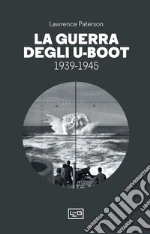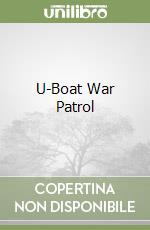 Libri di Lawrence Paterson su Unilibro.it
)
Libri di Lawrence Paterson su Unilibro.it
)
|
|
2024 |
 Title :
La guerra degli U-Boot 1939-1945
Title :
La guerra degli U-Boot 1939-1945Author: Paterson Lawrence Publisher: LEG Edizioni La narrativa storica comunemente accreditata sulla Seconda guerra mondiale associa gli U-Boot alla battaglia dell'Atlantico, come se la lotta per i convogli tra il nuovo e il vecchio mondo fosse isolata da eventi simultanei a terra e nell'aria. Si tratta però di un errore ormai quasi acquisito, poiché la guerra degli U-Boot non è esistita solo tra il 1940 e il 1943. Al contrario, la storia della seconda guerra degli U-Boot iniziò dal primo giorno di ostilità fra Germania, Gran Bretagna e Francia, e si concluse con l'affondamento dell'ultimo siluro il 7 maggio 1945. Gli U-Boot erano attivi in quasi tutti i teatri in cui prestò servizio la Wehrmacht e in tutti gli scenari marittimi, a esclusione dell'oceano Australe. Inoltre, i dispiegamenti furono spesso interconnessi, in virtù di quella che col tempo divenne una strategia navale sempre più inefficiente. Questo nuovo libro illustra il rapporto spesso diretto fra sottomarini e campagne terrestri, marittime e aeree delle potenze alleate e dell'Asse, sfatando alcune mitologie accettate e rivelando come il fallimento finale degli U-Boot derivò tanto dalla cattiva gestione militare e industriale tedesca quanto dai progressi degli Alleati nella decrittazione e negli armamenti. € 24,00
Scontato: € 22,80
|
|
|
1919 |
 Title :
Eagles over the Sea
Title :
Eagles over the SeaAuthor: Lawrence Paterson Publisher: PEN & SWORD BOOKS € 40,20
|
|
|
1918 |
 Title :
Hitler's Brandenburgers
Title :
Hitler's BrandenburgersAuthor: Paterson Lawrence, Higgins David R. (FRW) Publisher: Naval Inst Pr € 39,70
|
 Title :
Hitler's Brandenburgers
Title :
Hitler's BrandenburgersAuthor: Lawrence Paterson Publisher: PEN & SWORD BOOKS € 29,40
|
 Title :
Otto Kretschmer
Title :
Otto KretschmerAuthor: Lawrence Paterson Publisher: PEN & SWORD BOOKS € 29,90
|
 Title :
Weapons of Desperation
Title :
Weapons of DesperationAuthor: Lawrence Paterson Publisher: PEN & SWORD BOOKS € 20,50
|
||
|
1917 |
 Title :
Hitler's Forgotten Flotillas
Title :
Hitler's Forgotten FlotillasAuthor: Paterson Lawrence Publisher: Naval Inst Pr € 29,90
|
 Title :
Hitler's Gray Wolves
Title :
Hitler's Gray WolvesAuthor: Paterson Lawrence Publisher: Carrel Books € 37,60
|
|
1916 |
 Title :
Hitler's Grey Wolves
Title :
Hitler's Grey WolvesAuthor: Lawrence Paterson Publisher: PEN & SWORD BOOKS € 17,80
|
 Title :
Steel and Ice
Title :
Steel and IceAuthor: Paterson Lawrence Publisher: Naval Inst Pr € 34,20
|
 Title :
Steel and Ice
Title :
Steel and IceAuthor: Lawrence Paterson Publisher: History Press € 23,70
|
 Title :
U-Boat War Patrol
Title :
U-Boat War PatrolAuthor: Lawrence Paterson Publisher: PEN & SWORD BOOKS € 15,40
|
 Title :
Schnellboote
Title :
SchnellbooteAuthor: Paterson Lawrence Publisher: Naval Inst Pr The Kriegsmarine's Schnellboote--fast attack boats or E-boats to the Allies--were the primary German naval attack units in coastal waters throughout the Second World War. Operating close to their various bases they became a devastatingly effective weapon in nearly all the Kriegsmarine's theaters of war, from the Baltic to the Mediterranean and the Black Sea. It was in the English Channel, however, that the Schnellboote scored their most notable successes, destroying some forty warships and more than one hundred merchant ships. In addition to interception and attack, the boats were also used for minelaying, landing sabotage troops and general escort duties. To date, there has been no comprehensive operational history of the Schnellboote. However, due to the relatively small number of units, author Lawrence Paterson is able to recount the duties, fates, and careers of each individual craft in this new book. In addition, the smaller Schnellbootes designed for operations alongside the commando units of the Kleinkampfverbände are covered. As the war progressed, Schnellbootes suffered from the increased Allied mastery of the seas and skies but they were a formidable foe right to the end. This new book is the first to do full justice to their record of success. € 49,00
|
|
|
2004 |
 Title :
Hitler's Grey Wolves
Title :
Hitler's Grey WolvesAuthor: Paterson Lawrence Publisher: Motorbooks Intl Next to nothing has been written about the U-boat war in the Indian Ocean. This is the story of a forgotten campaign. The battle began in August 1943, when a German submarine arrived in the Malaysian harbour of Georgetown. In total, nearly fourty U-boats were assigned to penetrate the Indian Ocean, serving alongside troops of the occupying Imperial Japanese forces. The Japanese allowed U-boats to use Malaysia as an operational station. From that base, they mixed with Japanese forces on a hitherto unseen scale: a move which spread the U-boat war throughout the vast Indian Ocean and into the Pacific. Success in this theatre of war held a real chance to swing the tide of battle in North Africa in favour of Rommel, but the Germans essentially did too little too late. The joint action also gave U-boats the opportunity to penetrate the Pacific Ocean for the first time, attacking shipping off the Australian coast and hunting off New Zealand. Plans were even afoot for an assault on American supply lines. The cooperation' also brought into stark relief the fundamental differences of German and Japanese war aims. After the crews of Italian supply submarines joined the Germans and Japanese, relations between the fighting men of the three main Axis powers were often brutal and almost constantly turbulent. Stories of U-boats laden with gold and treasure stem almost exlusively from boats destined to and returning from Japanese-controlled Malaysia, laden with material exchanged between the two major partners of the Triple Axis Alliance. € 28,70
|
|